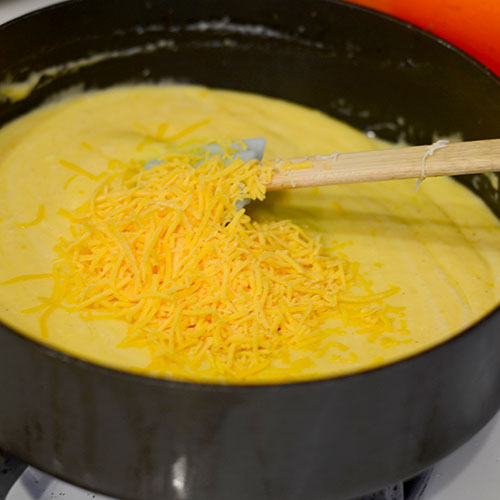I have made a roux so many times that I can make it in my sleep. If you have not learned how to make a roux, you will want to. A roux has so many applications and the basic technique is used in many forms of cooking from the French, to the Italians, to Cajun. A roux will elevate your game in the kitchen and it will up even your most basic dishes like macaroni N cheese.

Macaroni N Cheese
A roux is simply equal parts of butter and flour. Actually, these two ingredients are the base of a blond roux. If the two ingredients are canola oil and flour, then you have the base of a dark roux, and you are more than likely, making a Gumbo – one of my favorites! In a roux, the butter is melted and then the flour is added. The flour absorbs all the butter and forms a grainy looking type mixture. From this point, the flavor and consistency are developed depending on what you are making and the style of cooking you are following.

Cheese added to Roux

Cajun Pasta
If you are making a French inspired dish, then milk or cream is added to create what is known as a béchamel sauce. If you are making an Italian inspired dish, then milk, cream or stock is added to make a gravy – the base for a pasta sauce. Or Cajun for gumbo or the above Cajun Pasta. If, however, you are making the American invented macaroni and cheese, you will add milk, cream or my favorite adaption, coconut milk and chicken stock. I have tried many a combination for my sauce formed from my roux. I love the combination beginning with the coconut milk because the coconut milk provides a thick, rich texture. The stock is added to thin the sauce out just a little.
Once the creamy sauce is ready, the fun begins. In my macaroni N cheese, the cheese is added a little at a time on medium high heat until the cheese fully melts and is incorporated into the cream mixture. I should step back for one second and tell you that you want the coconut milk and stock at room temperature. If you pulled some from the fridge, be sure to heat it up in a sauce pan before adding to the roux. Getting back to completing the cheese sauce, keep adding the cheese in a little at a time until you reach the desired consistency of your cheese sauce. The dish is completed by pouring cooked pasta directly into the pan you made the cheese sauce in. So before you start, make sure you selected the right size pan to work with.


- 3 tablespoons butter
- 3 tablespoons all-purpose flour
- 2 teaspoon salt
- 2 teaspoon pepper
- 2 - 3 teaspoons smoked paprika (or cayenne)
- 1 - 14.5 ounce can of coconut milk
- 1 cup chicken stock
- Heat a dutch oven or skillet on medium heat.
- Add the butter and melt.
- Once the butter is melted, add the flour. Stir until the flour has fully absorbed the butter.
- Begin by adding a 1/2 cup or so of the coconut milk (make sure it is warm, at least room temperature)
- Cook until the flour butter mixture fully absorbs the coconut milk.
- Repeat again with another 1/2 cup of coconut milk.
- When it is fully absorbed, add 1/4 cup or so of the chicken stock and continue the process of stirring until the liquid is fully absorbed.
- Continue this process until all the liquid has been absorbed.
- If you want a thicker roux, keep the heat going and the mixture will thicken.
- The test to know it is done is to take a wooden spoon and the cream mixture should stick to the spoon. If it runs off, keep cooking the mixture. If it is too thick, you can add a little more stock.
- Play with this to get comfortable with the result.
- Now you are ready to make your sauce from this base.

Butter Melting
Next the flour is added and mixed until all the butter is absorbed.

Flour & Butter Absorbed
Then, the coconut milk and chicken stock are added a little at a time. Don’t add more in until the mixture is fully absorbed by the roux. Generally, I use about 2/3 to ¾ coconut milk and 1/3 to ¼ chicken stock.

1st Milk Being Added
The coconut milk and chicken stock are added in approximately 3 stages.

Alternating Between Coconut Milk and Chicken Stock

More Milk Added
The finally cream sauce has a very smooth texture. The best way to see if the consistency is correct is to drop in a wooden spoon. The cream sauce should adhere to the spoon, not drip off the spoon.

Roux almost Complete

Roux Finished
Thanks Peter and always enjoy step by step photos! Inspirational as always to me! Pinned and shared!
I love a roux-based sauce, so lovely this is a great guide – really interesting idea to use a mixture of coconut milk and stock, I usually just use normal milk!
this is a great guide – really interesting idea to use a mixture of coconut milk and stock, I usually just use normal milk!
Thx Becca. The coconut milk helps the texture a lot and no need for heavy cream then.
It’s nice to have step by step instructions. I tend to rush when I’m making a roux but I’ll get this out next time!
I know what you mean Michelle but this recipe goes pretty quickly.